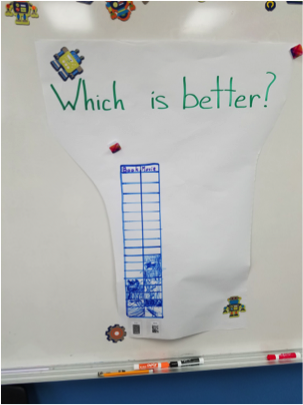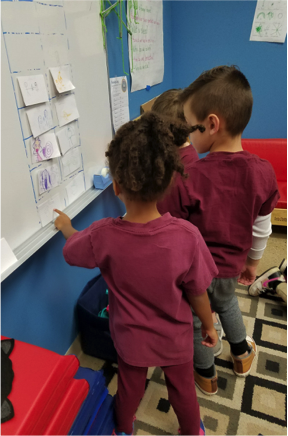Graphing as an Exploration
posted by Chris Kruger
The difference between an activity and an exploration
Exploration based learning may be all the rage, but not every Pinterest post is an exploration. Explorations are intensive, thoughtful investigations into a concept, while an activity is a solitary project, isolated from any surrounding work. In my Pre-K/K classroom, the emphasis is on explorations that take anywhere from a week to a month or more. In this series of posts, I will explore the groundwork I did to prepare for an exploration of graphing, the work we did with graphs for that month, the benefits of this exploration, and wrap up with some guidelines about how this mindset can be extrapolated to inform other explorations.
The seed of most of my math explorations comes from Little Kids – Powerful Problem Solvers by Andrews and Trafton. While I believe this book contains many great ideas, I’ve often felt it did not do enough to provide a full plan and instead simply explored a single activity. Therefore, when I read that our January exploration was going to be centered around graphing, I was certain that there were ways I’d need to expand it.
Laying the groundwork

I knew we’d be working on graphing in January, so I started several months earlier by seeing what the class already knew. They voted for whether the movie or book version of How to Train Your Dragon was better. After the vote, the class made a bar graph based on the votes cast. While they were working and during our discussion, I took careful notes about what prior knowledge the class already had.
Once the graph was completed, I questioned the class to see how well they could analyze the data. The whole class could tell who won and lost, which was reassuring. Most of the class was also able to tell how many people voted for book and how many voted for movie, another encouraging sign of comprehension. Further probing, however, revealed a number of weaknesses. No one was able to determine how many people had voted or how much the movie had won by. This, therefore, provided the baseline for the scope of my exploration.
While it is not necessary to have a full questionnaire before initiating an exploration, it is vital to check what prior knowledge the students have. You will almost certainly not have to cancel an exploration based on what the class already knows, but it is this tailoring that allows students to best grapple with the material later on.
Setting the scope
If you were going to attempt this exploration, it would be critical for you to determine what goals are appropriate in your setting and time frame. Students younger or you have a shorter time frame? Consider emphasizing the recognition of the larger picture of the graph (who won, what were the categories, etc). Students with a more developed mathematical ability? Push them to create graphs in groups or independently and spot errors in a graph based on the data set. Using this as a capstone to previous graphing explorations for advanced students? Have the class compare multiple representations of the same data to determine the ideal format or study misleading statistics.
With this range of goals in mind, I prepared for this exploration by determining what educational skills I wanted for the class to achieve. By the end of the month, I wanted my students to be have two related skills:

-Tell what information a graph is trying to depict.
-Be able to visualize how a set of numbers would look when graphed.
These were the two goals that all the work within this exploration would be working to address. As we move through this month, these goals will be the lens through which all of the activities will be evaluated.
This scalability is not unique to graphing. Many, if not most, topics in mathematics can be easily adjusted up or down. The final post this month will detail how to do this, but rest assured the teaching moves discussed here are generally applicable.
Creating a Sequence
This is one of the trickiest parts of the process: what is the actual work the students are going to do? I’m a worrier, so the trap I find myself falling into is making a timeline: Monday do this and ask this, Tuesday this and that, etc. However, since the goal isn’t me being able to do these activities, it is unwise to make too precise of a timeline. Instead, it is more efficient to make a sequence of topics or activities the class can cover. This way, I have a vision of where we can go and what to prepare, but I’m letting the class determine the pace. For this exploration, I decided to start with bar graphs and move into pictographs in the third week. In addition, it is useful to consider the breadth of questions that can be asked. This vision of exploration preparation will be explored more in the final blog post this month, so check back for a fuller explanation.
Check back next week as the rubber hits the road and we actually start graphing!
interesting!
Great ideas. I will use them in my classroom
I like these ideas and will put them to use in my classroom.